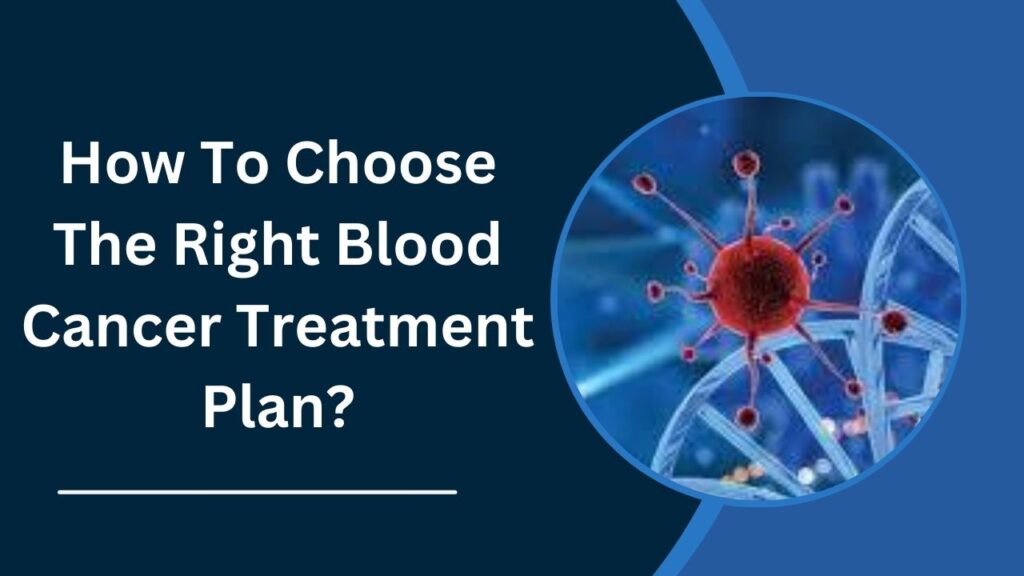Choosing the right blood cancer treatment plan involves a personalized approach, considering various factors specific to the individual, the type of blood cancer, and the treatment goals. Here’s a comprehensive guide on how to make this decision:
1. Understand the Type of Blood Cancer
Blood cancers can be broadly categorized into three types:
Leukemia: Cancer of the bone marrow and blood.
Lymphoma: Cancer of the lymphatic system.
Myeloma: Cancer of the plasma cells in the bone marrow.
The specific type of blood cancer, whether it’s acute or chronic, and whether it’s a form of leukemia, lymphoma, or myeloma, will significantly influence the treatment options.
2. Consult with a Hematologist or Oncologist
A hematologist-oncologist specializes in blood cancers and will help guide you through the diagnosis, staging, and treatment options. You may also be referred to a team of specialists, depending on the complexity of your case.
3. Assess the Stage and Progression of the Disease
Early Stage: If the cancer is detected early (localized, with fewer affected cells), treatment may be less aggressive and focused on remission induction.
Advanced Stage: For more advanced or widespread diseases, treatment may need to be more intensive and multipronged (combining chemotherapy, radiation, and/or stem cell transplants).
4. Determine the Treatment Goals
Your goals will affect the treatment plan:
Curative Treatment: If possible, the goal is to eliminate the cancer.
Remission Induction: Even if a cure is not possible, remission (absence of symptoms and reduction of cancer cells) can significantly improve quality of life and longevity.
Palliative Care: If the cancer is advanced or treatment is unlikely to cure the disease, care may focus on symptom management and improving quality of life.
5. Review Available Treatment Options
Treatment for blood cancers can include:
- Chemotherapy
Used in leukemia and lymphoma to target rapidly dividing cells.
Chemotherapy is typically administered intravenously or in some cases orally.
Combination therapies are often used to increase effectiveness.
- Targeted Therapy
Targets specific molecules involved in the growth and spread of cancer cells.
Can be less toxic than traditional chemotherapy.
Common in chronic leukemia and certain lymphomas.
- Immunotherapy
CAR Tcell Therapy: Involves modifying a patient’s immune cells to target cancer.
Monoclonal Antibodies: Target specific proteins on the surface of cancer cells to either kill them or stop them from growing.
Used in lymphomas and some leukemias.
- Stem Cell or Bone Marrow Transplant
A stem cell or bone marrow transplant can be a curative option for certain types of leukemia, lymphoma, or myeloma.
It involves replacing the diseased bone marrow with healthy stem cells, either from a donor (allogeneic) or from the patient’s own cells (autologous).
- Radiation Therapy
Radiation is sometimes used to target localized areas, such as a tumor or lymph node, to shrink it or kill cancer cells.
It may be combined with other treatments like chemotherapy.
- Other Treatments
Steroids: Often used in combination with chemotherapy to reduce inflammation and treat
symptoms.
Antiviral and Antifungal Treatments: Sometimes needed to treat infections or prevent complications during treatment.
6. Consider Side Effects and Impact on Quality of Life
Different treatments come with varying degrees of side effects. It’s important to discuss potential side effects, such as:
Hair loss
Nausea and vomiting
Fatigue
Risk of infections
Longterm effects, including organ damage or secondary cancers
Work with your doctor to weigh the potential benefits of treatment against these risks. Some newer treatments, like targeted therapies and immunotherapies, tend to have fewer side effects than traditional chemotherapy.
7. Look at Clinical Trials
Clinical trials offer access to new treatments that may not be widely available. Participating in a clinical trial can be a good option for patients with advanced blood cancers who have exhausted standard treatments. Discuss available trials with your doctor and see if you qualify.
8. Consider Your Personal Preferences and Lifestyle
Treatment plans should also take into account your personal preferences, age, overall health, and lifestyle. For example:
How much time and effort can you dedicate to treatment (frequent hospital visits, long recovery times)?
How does the treatment align with your personal goals, like maintaining a good quality of life?
9. Get a Second Opinion
Given the complexity of blood cancers, getting a second opinion from another experienced hematologist or oncologist can help confirm the best approach for your case. It also allows you to explore other treatment options or clinical trials that may not have been discussed initially.
10. Ongoing Monitoring and Adjustments
Blood cancers often require ongoing monitoring, as relapses or changes in the disease can occur. Your treatment plan may need to be adjusted over time based on how the cancer responds. Regular checkups, blood tests, and imaging will help guide any necessary changes.
11. Support Systems and Counseling
Finally, consider the emotional, psychological, and social aspects of treatment. Blood cancer treatments can be intense, and it’s important to have a strong support network—whether that’s family, friends, or professional counselors. Support groups specifically for people with blood cancer can be valuable for emotional and practical advice.
Summary of Key Steps:
Identify the type and stage of your blood cancer.
Work closely with your hematologist to understand treatment options.
Choose the treatment approach based on your cancer type, treatment goals, and personal preferences.
Be open to clinical trials and second opinions.
Keep monitoring and adjusting your treatment plan as needed.
Blood cancer treatment is a dynamic and evolving process, and it’s important to take a proactive role in your treatment decisions. Your oncologist can provide guidance, but ultimately, the plan should be one that aligns with your goals, health status, and lifestyle.



